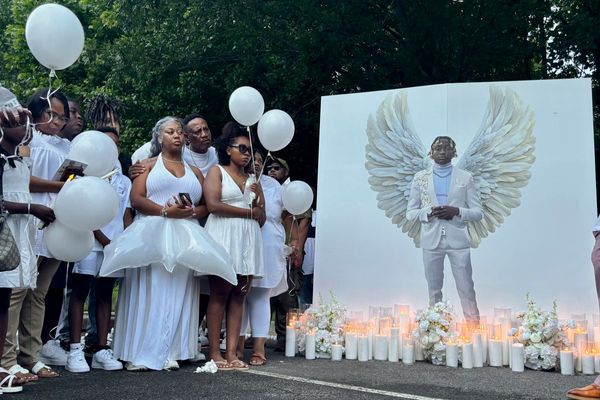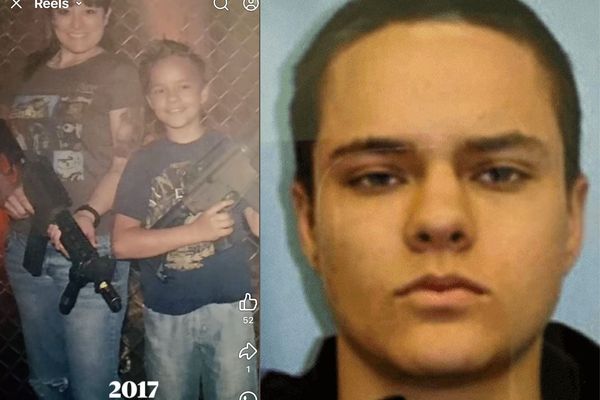
Sally Capp was in her mid-20s when she considered leaving Melbourne – a city that, as lord mayor, she’s since led through the world’s longest lockdown – in search of an “interesting life”.
It was 1992, and the financial crisis had turned Melbourne into a “moribund city and a rust bucket state” according to Capp, who was then a lawyer for Herbert Geer & Rundle.
“I remember walking to the train station one night at 6pm and it was deserted – the city was so quiet,” she says.
“I remember thinking, have I got a future here in this city? Am I going to have to move away to pursue my career and have an interesting life? And, thankfully, the answer was no.”
Capp points to the Postcode 3000 plan of the early 1990s – credited with transforming the city’s Hoddle Grid from a ghost town into a bustling night-time economy – as being responsible for the era’s huge urban transformation and her decision to stay put.
Thirty years later, the lord mayor now finds herself at the helm of Melbourne’s latest transformation project: reviving the city’s arts and culture scene after almost two years of the pandemic.

The state government last month scrapped its indoor mask mandate and lifted the work-from-home recommendation. But rebuilding the cultural scene of Melbourne – a city previously acclaimed as being the world’s most liveable and the nation’s live music capital – is a hefty task.
The Melbourne city council is investing, with the state government, in subsidised retail spaces to revitalise vacant shopfronts. There’s also an injection of $10m in funds to rejuvenate 40 of the city’s world-famous street-art laneways as drawing points to re-attract visitors and nurture creativity.
In the live music scene, there are promising signs of revitalisation. There’s the creation of a new state-wide performance program that saw the Foo Fighters become the first major international act to travel to Australia since the pandemic began.
But the state’s smaller band rooms and venues say they remain decimated from two years of the pandemic and are calling for an industry-led elected roundtable to present proposals to government to save the sector.
Capp says the council is now stretching its imagination and considering proposals that were previously placed in the “too hard basket” due to cost and logistics – such as expanding outdoor events to include more inner-city street closures, drawing on the pandemic’s trend of reclaiming public spaces.
“Overall, it’s about us being more of a city of ‘yes’ to some of those ideas,” she says.
“It’s that sense of creativity, it’s the irreverence, it’s the thinking outside the box. It’s a sense of adventure – even misadventure – that the whole creative sector brings to communities, cities and economies that’s so important. So absolutely we’re dedicated to making sure that we remain that cultural capital.”

At the heart of the new revival strategy is foot-traffic data that points to the emergence of a new CBD rhythm: Wednesday has become the city’s busiest day, and twilight the most popular time period.
Capp says the council’s night-time economy advisory committee is “rallying” to develop a new program of events scheduled in the 4-7pm time slot to “activate” the twilight period.
“Traditionally, there hasn’t been a lot of thought put into twilight,” she says.
“We’re looking at: can we run a big busking program just to stop people and get them to be entertained and engaged? Or can some live music venues have an earlier set that starts at 5pm and finishes at 6.30pm – then people may go on to something else?”
The Melbourne Symphony Orchestra this year added “Quick Fix at half six” performances on Monday evenings to its 2022 schedule. The MSO’s managing director, Sophie Galaise, says they’re designed for audiences wanting to enjoy an earlier performance.
“The idea is: come to your office – if you still have one. Join us right after your work. It’s only one hour, and you can have a drink before, and dinner after,” Galaise says.
“It’s an uplifting start to the week, so people may be more likely to return to the city later in the week. People just love having a good time – and we’re a provider of good times and extraordinary beauty.”
The state government is launching an “Art After Dark Melbourne” that will see museums – including the National Gallery of Victoria and the state library – host special events until 1am, but over the course of a weekend in May, rather than during the week.
James Young, the owner of CBD live music venue Cherry Bar and chair of the council’s night-time economy advisory committee, is adamant the city’s rhythm has changed and hybrid office schedules must be embraced for the next stage of Melbourne’s cultural revival. Young says the Melbourne zoo’s popular twilights series has been a source of inspiration for the revitalisation of the early evening period.
“We’re thinking about it across the entire city, where you’d have a twilight program, and some precincts would be family focused, art focused, Indigenous-education focused. But it’s the idea of doing something far-reaching that hasn’t been owned before by a city. So it’s one suggestion that has been made to the City of Melbourne which it’s considering,” he says.

But Young believes the key to the city’s cultural revival is also “establishing a new Melbourne” that reimagines what the CBD is.
“As much as we’re keen to resuscitate the CBD, we think the future of Melbourne is not around a central business district but rather a radical rethink, where we might refer to our cities as having a central social district or a central experience district,” he says.
Young says Melbourne should follow “forward-looking” countries like Iceland and Belgium that moved towards adopting four-day working weeks – with the same pay – arguing it has the potential to transform the cultural landscape.
“The thing about the four-day week is by rotating that day off throughout the week, you can help activate that night off. Because if we have tomorrow off, we’re going out tonight,” he says.
“That would have an enormous impact on the restaurants, hospitality, entertainment and the theatres if this kind of thinking was adopted.”
While the city’s bold visionaries are looking to other cities, Young also believes the world’s eyes are on Melbourne.
“When you’re the most locked-down city, when you’re set free, you’re the most free,” he says.
“I think the whole world is looking at Melbourne thinking, what are you about to produce? What’s going to happen in Melbourne? Because they were repressed the most and are known for their creative community.”
“If we get this right, the way we set up Melbourne now will be talked about for decades. People will look back and think a pivotal moment in the growth and definition of Melbourne was 2022, when they came out of those two horror years and they thought about themselves differently and did things differently.”
For Capp, Melbourne’s exuberance for live shows is one thing she believes is here to stay in the next chapter of the city’s culture.
When the city emerged from the Delta lockdowns of 2021, Capp stood outside Regent theatre after a Sunday afternoon performance of Moulin Rogue and “let that energy of people coming out of there wash over me”.
“It was wonderful and I think that’s what really makes Melbourne distinctive is that sense of excitement and energy that people have when they’ve just experienced something fantastic,” Capp says.







